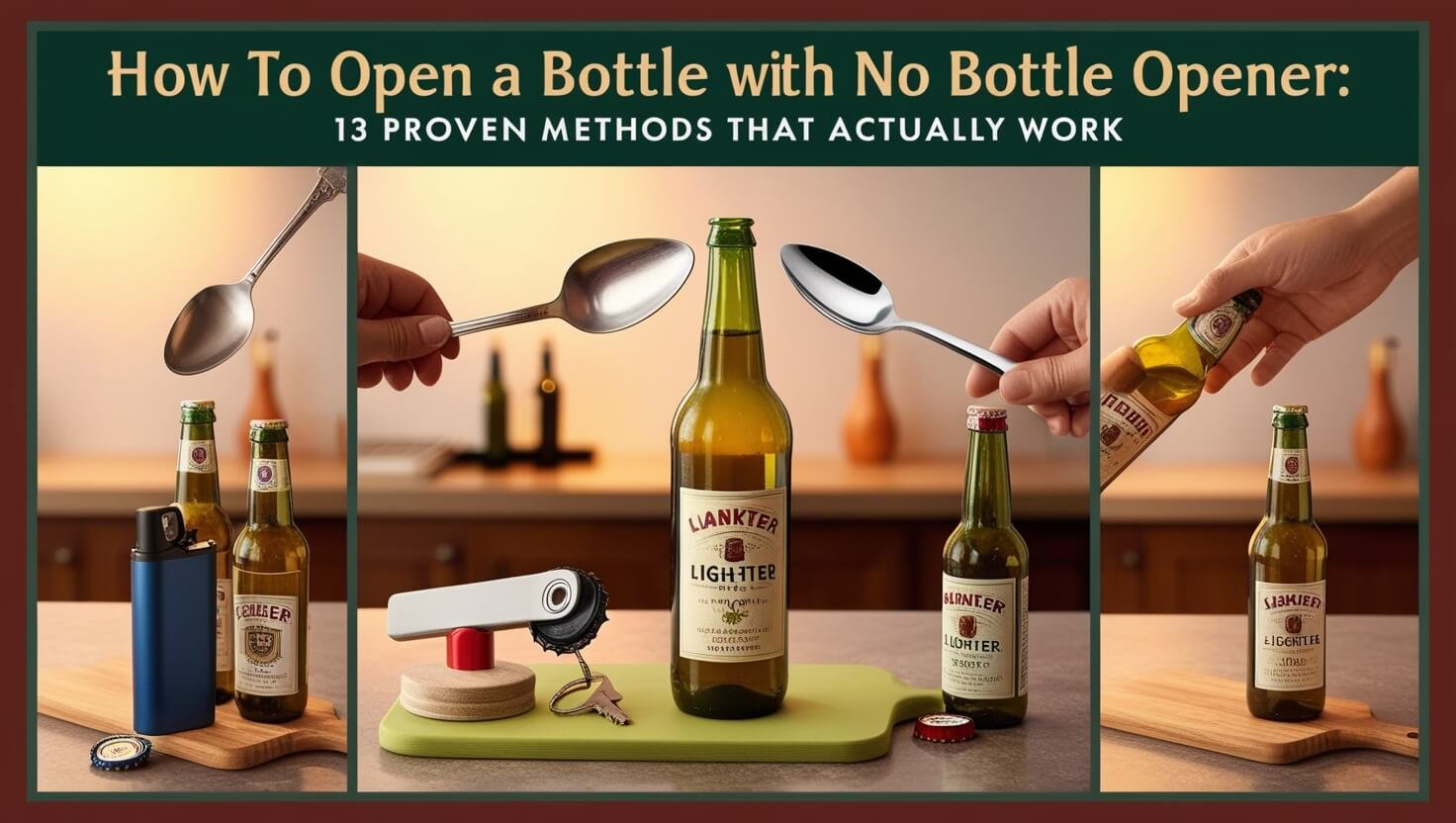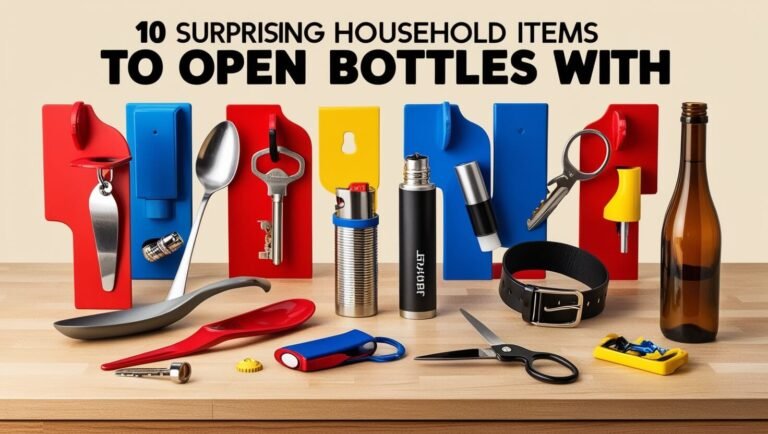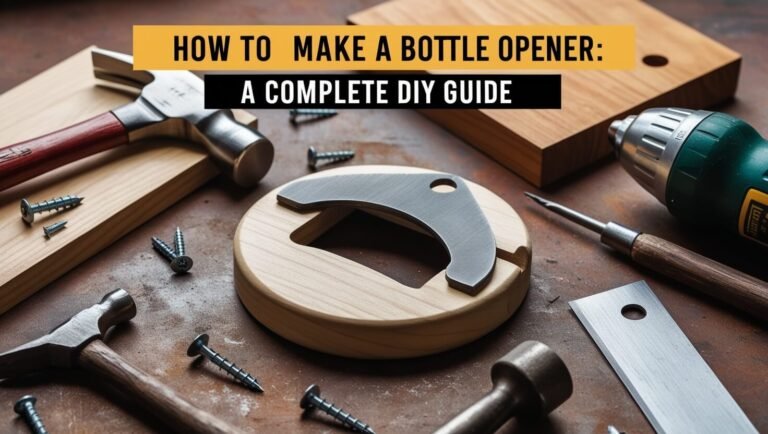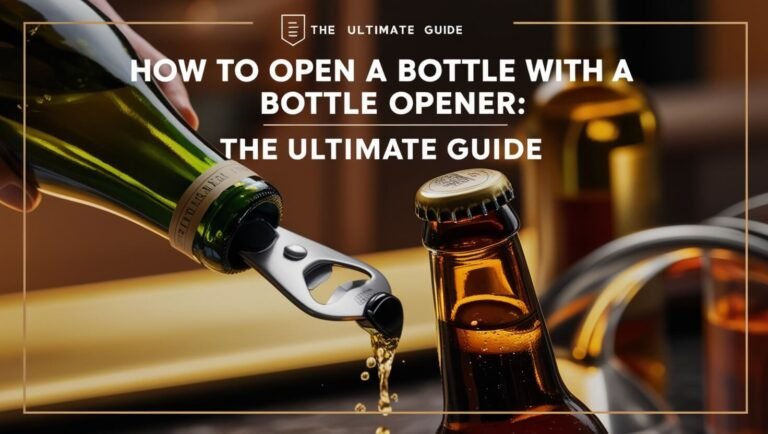How to Open a Bottle with No Bottle Opener: 13 Proven Methods That Actually Work

Lost your bottle opener? No problem. You can safely open a bottle using common household items like spoons, keys, or even a dollar bill. The quickest and safest method is using a spoon as a lever against the bottle cap’s edge while keeping your hand away from sharp edges.
Finding yourself with a sealed bottle and no opener is frustrating. Whether you’re at a backyard barbecue, camping trip, or just relaxing at home, knowing these proven techniques can save the day. Let’s explore practical, tested methods to open bottles safely using items you already have around you.
Safe and Essential Tips Before Opening a Bottle Without an Opener
Before attempting any bottle-opening technique, understanding proper safety measures is crucial. These methods work well when done correctly, but rushing or using improper technique could lead to injury or broken glass.
When to Try These Methods (and When Not To)
Use these alternative opening methods when:
- You have a standard pry-off bottle cap
- The bottle is at room temperature
- You’re in a stable environment with good lighting
- You have time to attempt the method carefully
Avoid these techniques if:
- The bottle is damaged or cracked
- You’ve been drinking heavily
- You’re in an unstable position
- The bottle is under unusual pressure or shaken
Safety Precautions to Keep in Mind
- Always point the bottle away from yourself and others
- Wear closed-toe shoes
- Have a towel ready to clean up any spills
- Keep a first aid kit nearby
- Never use excessive force
Types of Bottles These Methods Work Best With
- Standard glass beer bottles
- Soft drink bottles with pry-off caps
- Mineral water bottles with metal caps
- Craft beverage bottles
These techniques don’t work well with:
- Twist-off caps (check for horizontal lines on the cap)
- Champagne or sparkling wine bottles
- Corked bottles
- Plastic screw-top bottles
Everyday Household Items to Open Your Bottle
Opening a Bottle with Spoons and Forks
The spoon method is arguably the safest and most reliable technique. Here’s how to do it:
- Hold the bottle firmly on a stable surface
- Position the spoon’s edge under the bottle cap’s crimped edge
- Push down on the spoon handle, using it as a lever
- Work your way around the cap, loosening it bit by bit
- Pop the cap off once it’s sufficiently loosened
Pro tip: Metal spoons work better than plastic ones, and soup spoons provide better leverage than teaspoons.
Using Keys as Emergency Bottle Openers
Your house or car key can serve as an impromptu bottle opener:
- Hold the bottle securely in your dominant hand
- Position the key’s edge under the bottle cap at a 45-degree angle
- Use your thumb as a fulcrum point
- Push the key up while keeping the bottle steady
- Repeat around the cap until it loosens
Warning: This method may damage your keys over time, so use it sparingly.
The Dollar Bill Method
This unique technique works surprisingly well:
- Fold a dollar bill (or any sturdy paper) as tightly as possible
- Fold it in half lengthwise multiple times
- Position the folded edge under the bottle cap
- Use the paper as a lever to pry up the edge
- Work around the cap until it pops off
Ring Technique (Dos and Don’ts)
While some suggest using rings to open bottles, we recommend against it because:
- It can damage expensive jewelry
- Risks injury to your fingers
- May bend or break the ring
- Could chip stones in decorated rings
Using a Lighter to Pop the Cap
For those who smoke or carry lighters:
- Grip the bottle neck firmly
- Position the lighter’s base under the cap edge
- Use your index finger as a fulcrum
- Push down on the lighter’s other end
- The cap should pop off with moderate pressure
Important: Keep the bottle pointed away from others, as caps can fly off unexpectedly.
Kitchen and Home Tools That Work as Bottle Openers
Counter Edge and Table Method
This technique requires caution to protect your furniture:
- Find a sturdy counter edge
- Place a dish towel over the edge to prevent damage
- Position the cap’s edge on the counter
- Push down firmly while gripping the bottle
- The cap should pop off with one smooth motion
Using Flathead Screwdrivers
A flathead screwdriver can work like a traditional bottle opener:
- Choose a medium-sized screwdriver
- Insert the flat edge under the cap
- Lever up slowly
- Work around the cap methodically
- Keep your free hand away from the screwdriver’s path
The Spoon Leverage Technique
This variation of the spoon method focuses on maximum leverage:
- Choose a sturdy metal spoon
- Position the spoon’s bowl against the bottle’s neck
- Place the spoon’s edge under the cap
- Pull back while keeping the bowl against the neck
- Listen for the satisfying pop
Belt Buckle Method
For those wearing a belt with a sturdy buckle:
- Remove your belt (or don’t – your choice)
- Find the prong or edge of the buckle
- Position it under the bottle cap
- Use the same motion as a regular bottle opener
- Clean your buckle afterward
Door Frame Strike Plate Technique
The metal plate on door frames can work in a pinch:
- Locate the metal strike plate
- Position the bottle cap edge against it
- Push the bottle upward quickly
- Be ready to catch the cap
- Clean any marks left on the plate
Creative Methods for Specific Situations
Opening a Bottle with Another Bottle
When you have two bottles but no opener:
- Open one bottle first using another method
- Use the opened bottle’s base edge
- Position it under the other bottle’s cap
- Lever up carefully
- Keep both bottles at an angle to prevent breakage
The Bike Pedal Method
Perfect for cyclists or when near a bicycle:
- Turn the bike upside down or access the pedal
- Find the serrated edge on the pedal
- Position the bottle cap against it
- Push down firmly
- Clean the pedal afterward
Using a Cocktail Strainer
Many Hawthorne strainers have a perfect edge for opening bottles:
- Hold the coil part of the strainer
- Find the edge that extends past the coil
- Position it under the bottle cap
- Lever up as with a normal bottle opener
- Clean the strainer before using it for drinks
Car Door Striker Method
Similar to the door frame technique:
- Locate the metal striker on your car door frame
- Position the bottle cap against it
- Pull up firmly but controlled
- Be careful not to damage your car’s paint
- Have a container ready for the cap
Common Mistakes to Avoid
Dangerous Methods You Should Never Try
Stay away from these risky techniques:
- Using your teeth (serious dental damage risk)
- Smashing the neck against a hard surface
- Using sharp knives
- Attempting to drill or puncture the cap
- Using glassware as leverage
How to Prevent Bottle Breakage
Follow these guidelines to keep bottles intact:
- Never apply excessive force
- Support the bottle’s neck properly
- Work slowly and methodically
- Stop if you hear cracking sounds
- Check for existing damage before starting
Protecting Your Surfaces and Tools
Maintain your furniture and tools:
- Always use protective barriers
- Clean tools immediately after use
- Check for damage between attempts
- Keep surfaces dry
- Use dedicated areas for opening bottles
Pro Tips from Beverage Experts
Bartender-Approved Emergency Methods
Professional insights from experienced bartenders:
- The spoon method is most reliable
- Leverage is more important than force
- Practice with empty bottles first
- Keep backup openers in multiple locations
- Learn to identify twist-off caps quickly
Best Practices for Different Bottle Types
Match your technique to the bottle:
- Standard beer bottles – any leverage method works
- Larger bottles – need more stable support
- Smaller bottles – require more careful handling
- Specialty caps – may need specific approaches
- Older bottles – handle with extra care
Expert Recommendations for Various Settings
Situation-specific advice:
- Home: Use kitchen tools and stable surfaces
- Outdoors: Look for sturdy natural edges
- Parties: Keep multiple backup options ready
- Travel: Learn portable techniques
- Professional settings: Always have proper tools
Frequently Asked Questions
Which Method Is Safest?
The spoon method ranks highest for safety because:
- It provides good control
- Uses common, sturdy tools
- Keeps hands away from sharp edges
- Allows for gradual pressure
- Works consistently across bottle types
Can These Methods Damage the Bottle?
Yes, improper technique can cause damage:
- Chipped bottle necks
- Cracked glass
- Bent bottle caps
- Scratched surfaces
- Contaminated contents
Will These Techniques Work on All Bottle Types?
No, these methods are primarily for standard pry-off caps. They won’t work effectively on:
- Twist-off caps
- Corked bottles
- Plastic screw tops
- Crown caps larger than standard
- Security sealed bottles
How to Tell If a Bottle Is Twist-Off?
Look for these indicators:
- Horizontal lines on the cap
- Knurled edges
- Slightly larger cap size
- Brand-specific markings
- Smoother cap texture
Remember, when in doubt, test gently by attempting to twist before trying pry-off methods.
The Bottom Line
Opening a bottle without a proper opener is possible with everyday items and careful technique. While these methods can work in a pinch, investing in a quality bottle opener and keeping it handy remains the safest and most reliable solution. Whatever method you choose, prioritize safety and take your time to avoid injury or damage to the bottle.
Whether you’re using a spoon, counter edge, or any other technique, remember that patience and proper leverage matter more than force. Keep these methods in your back pocket for those times when you need them, but consider them temporary solutions rather than long-term alternatives to proper tools.





